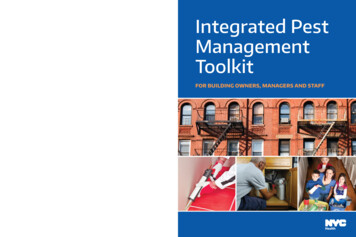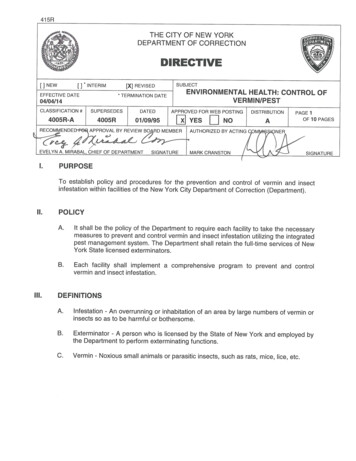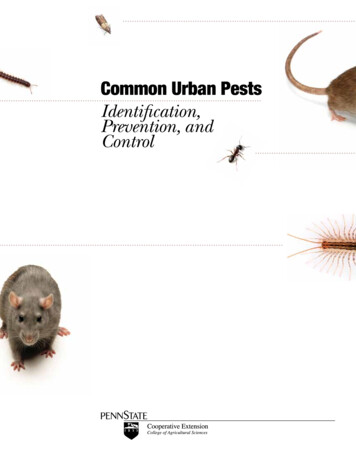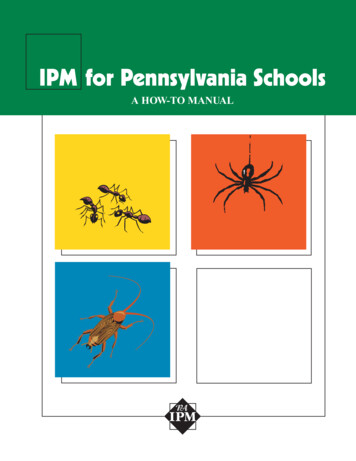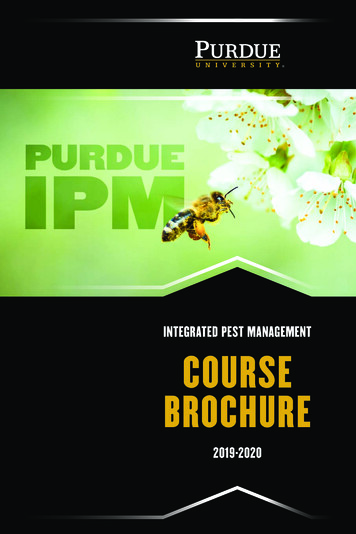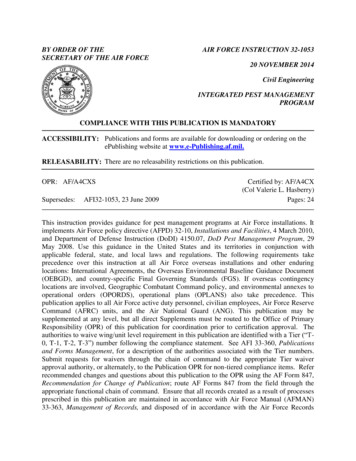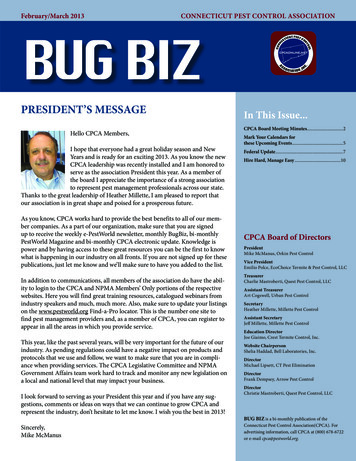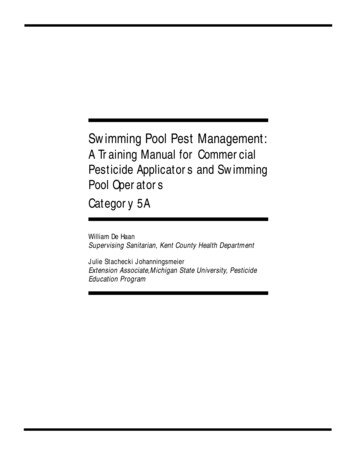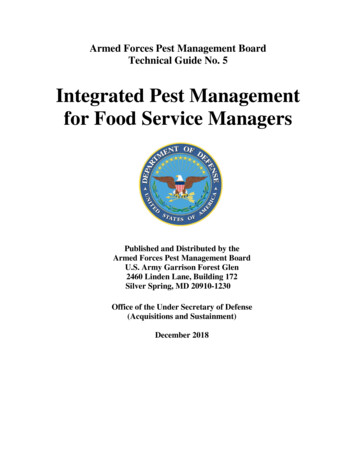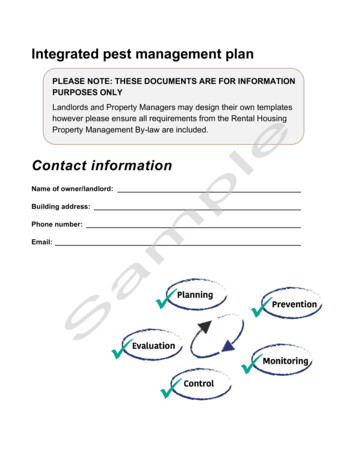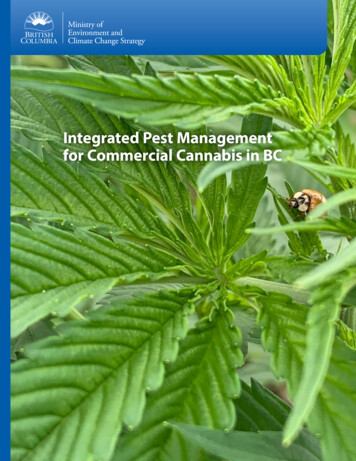
Transcription
Integrated Pest Managementfor Commercial Cannabis in BC
iiIntegrated Pest Management ProgramCommercial CannabisTable of ContentsiiiPhoto/graphic credits1What is the role of the province in pest management?2Cannabis Pest Management2Integrated Pest Management (IPM)2Prevention3Identification4Monitoring4Action Thresholds5Management Options7Evaluation889101112131414Pests found on foliage and flowers15151617Root pests18Registered Products for Cannabis Grown Commercially Indoors19Available Resources20Questions?20References used in the creation of this documentAphidsThripsTwo Spotted Spider Mites (Tetranychus urticae)Broad Mites (Polyphagotarsonemus latus)CaterpillarsPowdery mildewBud RotHemp Russet Mites (Aculops cannabicola)Root aphids (Rhopalosiphum rufiabdominalis)Fungus gnatsRoot RotThe information in this manual is supplied with the understanding that no discrimination is intended andthat listing of products implies no endorsement by the B.C. Ministry of Environment and Climate ChangeStrategy. Labels, laws, and regulations may change over time. The B.C. Ministry of Environment and ClimateChange Strategy assumes no liability for the suggested use of pesticides or other products contained herein.
Integrated Pest Management ProgramCommercial CannabisPhoto/graphic creditsCover: Photo courtesy of Emily CarmichaelPg. iv: Photo courtesy of Tom UlanoskwiFig. 17: Photo courtesy of Alton N. Sparks Jr.,UOG, Bugwood.orgFig. 1: ThinkstockFig. 18: Photo courtesy of Emily CarmichaelFig. 2: Photo courtesy of Upland ConsultingFig. 19: Photo courtesy of Emily CarmichaelFig. 3: Ministry of Environment andClimate Change StrategyFig. 20: Photo courtesy of Mario Lanthier,CropHealth Advising & ResearchFig. 4: Ministry of Environment andClimate Change StrategyFig. 21: Photo courtesy of Mario Lanthier,CropHealth Advising & ResearchFig. 5: Photo courtesy of Tom UlanowskiFig. 22: Photo courtesy of Mario Lanthier,CropHealth Advising & ResearchFig. 6: Photo courtesy of Tina Ziaei,Bioline AgrosciencesFig. 7: Ministry of Environment andClimate Change StrategyFig. 8: Ministry of Environment andClimate Change StrategyFig. 23: Photo courtesy of Emily CarmichaelFig. 24: Photo courtesy of David Kidd, usedwith permission from the University ofCalifornia Statewide IPM ProgramFig. 25: Photo courtesy of Zamir PunjaFig. 9: Photo courtesy of Tom UlanowskiFig. 26: Photo courtesy of Zamir PunjaFig. 10: Photo courtesy of PestManagement Regulatory AgencyFig. 27: Photo courtesy of Zamir PunjaFig. 11: Photo courtesy of Tina Ziaei,Bioline AgrosciencesFig. 12: Photo courtesy of Tom UlanowskiFig. 28: Photo courtesy of W. Cranshaw,CSU, Bugwood.orgFig. 29: Photo courtesy of W. Cranshaw,CSU, Bugwood.orgFig. 13: Photo courtesy of Tina Ziaea,Bioline AgrosciencesFig. 30: Photo courtesy of Kelly VanceFig. 14: Photo courtesy of WhitneyCranshaw, CSU, Bugwood.orgFig. 32: Photo courtesy of Kelly VanceFig. 15: Photo courtesy of WhitneyCranshaw, CSU, Bugwood.orgFig. 16: Photo courtesy of Emily CarmichaelFig. 31: Photo courtesy of Kelly VanceFig. 33: Photo courtesy of W. Cranshaw,CSU, Bugwood.orgFig. 34: Ministry of Environment andClimate Change StrategyThe Ministry of Environment and Climate Change Strategy gratefully acknowledges thecontributions of Zamir Punja and Peter Doig in the external review of this document.Copyright 2019, Province of British ColumbiaAll rights reserved.iii
ivIntegrated Pest Management ProgramCommercial Cannabis
Integrated Pest Management ProgramCommercial CannabisWhat is the role of the province in pest management?Pesticides are used in almost all sectors, includingcannabis production. Pesticide use is regulated by boththe federal and provincial governments. The federalgovernment evaluates, regulates and registers thepesticides allowed for use in Canada through the PestControl Products Act. Health Canada’s Pest ManagementRegulatory Agency (PMRA) undertakes this work. Theprovincial government regulates the sale, transport,storage, disposal and application of pesticides inBC through the Integrated Pest Management Act andRegulation. This is done through the Integrated PestManagement Program of the Ministry of Environmentand Climate Change Strategy. The Ministry relies on thefederal Pest Control Products Act, and the expertise ofthe PMRA, to evaluate and determine acceptable usesfor pesticides registered for sale in BC. There is someoverlap of responsibilities between these two levels asoutlined below. Both federal and provincial complianceofficers are involved in inspections at cannabis facilities.Did you know?Before a pesticide is registered, it must undergoextensive health and environmental safety reviewsand evaluations. If the results of the studiesmeet the standards of PMRA, the product getsregistered. The results and information from thesestudies are written into a pesticide label, usuallyin the form of safety instructions and directionsfor use. Once a pesticide is registered, it is given aregistration number, also known as a Pest ControlProducts Number. Products that do not have thisnumber have not been tested by Health Canadaand must not be used.Federal Primary Regulatory Tool: Pest Control Products Actand Regulation Health Canada’s Pest Management RegulatoryAgency (PMRA) evaluates and registers pesticidesand sets basic use conditions Enforces product label use and verifies compliance Promotes sustainable pest management Provides educationProvincial Primary Regulatory Tools: Integrated PestManagement Act and Regulation Regulates the sale and use of pesticides in BC Responsible for training and certifying pesticideapplicators and dispensers Verifies compliance Issues authorizations Promotes integrated pest management to reduceunnecessary pesticide use Provides education1
2Integrated Pest Management ProgramCommercial CannabisCannabis PestManagementIntegrated PestManagement (IPM)Cannabis is susceptible to many pests, including insects,mites, fungi or bacteria. To date, no viruses have beenconfirmed. The damage from pests can stunt plantgrowth and decrease the yield and quality of the finalproduct. A number of pesticides are registered for useon cannabis grown commercially indoors in Canada.They are outlined in Table 1 which can be found onpg. 18. These pesticides may be considered incombination with other techniques as part of anintegrated pest management (IPM) program toeffectively manage pests in cannabis. This documentprovides guidance on best practices for pestmanagement for commercial cannabis grown indoorsand in greenhouses, and outlines the availablechemical and non-chemical control options for pestscommonly found in this crop.IPM is a decision-making process for managing pestsin an effective, economical and environmentally soundway, which includes six mentOptionsIPMconceptsAction ThresholdFig. 1: IPM Components1) Prevention: planning and managingproduction systems to prevent pests2) Identification: identifying pests, theirdamage and their natural enemies3) Monitoring: regular monitoring of pestpopulations, pest damage, beneficial organismsand environmental conditions4) Action Thresholds: making control decisionsbased on potential damage, cost of controlmethods, value of production, impact on otherpests, beneficial organisms and the environment5) Management options: may include acombination of behavioral, biological, chemical,cultural and mechanical methods to reduce pestpopulations and damage to acceptable levels6) Evaluation: conducting follow up evaluationsto determine the effects and efficacy ofmanagement decisionsPreventionMonitoringIt is essential to focus on pest prevention due to thelimited number of registered pesticides for commercialcannabis growers. When pest problems are prevented,the need for other control measures is reduced.Prevention Strategy: Mother plantsWhen growing any crop, pest management shouldstart in propagation. Mother plants, also called ‘moms’or ‘mums’, are stock plants used to take cuttings forpropagation. Because mother plants are generally keptlonger than all other plants in production, they canaccumulate pests that are then transmitted throughclones or cuttings. A strong focus on keeping motherplants clean is a key pest prevention strategy.
Integrated Pest Management ProgramCommercial Cannabis Adopt good sanitation practices. When planting,use sterilized potting media. Tools, pots, trays,pruners, trimmers and any growing shelving shouldbe sterilized between uses. Manage nutrients to avoid flushes of lush vegetativegrowth. This can make plants more susceptible tocertain diseases and more attractive to certain pests. Maintain a buffer-zone free of weeds and vegetationaround the outside of any greenhouse. Keep the inside of greenhouses weed-free.Fig. 2: Mother plantsGeneral prevention strategies Avoid bringing house plants into any part ofgrowing facilities.General prevention strategies that can be applied tomost pests include the following: Choose plant varieties that are resistant to pestsand diseases. Keep more susceptible plant varieties separate fromother varieties to limit the spread of pests. Provide good ventilation and air flow in thegrowing area. Use insect netting to screen vented areas to preventpests from coming in from outside. Restrict movement of workers within growing areasto reduce unintentional spread of pests, and alwaysvisit areas experiencing the highest amount of pestpressure last. Install footbaths at entrances. Maintainthem regularly. Limit visitors that could unintentionally be carryingpests on their clothing. Provide protective clothingto visitors. Inspect all incoming plant materials from outsidesources and keep in a quarantined area for adesignated period of time to ensure pests do notspread to existing plant material.Fig. 3: Ministry of Environment and ClimateChange Strategy compliance staff wearingprotective clothing provided by the facilityIdentificationPests must be correctly identified to select appropriatecontrol treatments. Learning about the pest’s behaviourand life cycle will guide decisions on when to takeaction, what techniques to use to reduce the numberof pests, and how to prevent pests from enteringproduction facilities. An overview of common pestsof cannabis, their characteristics and typical signs ofdamage can be found throughout this document.3
4Integrated Pest Management ProgramCommercial CannabisMonitoringAlways monitor for pest populations, beneficialorganisms and environmental conditions that cancause pest problems. Regular monitoring allows anearly detection of pests and provides the informationrequired to make decisions about the timing andlocation of treatments and whether they are necessary.Monitoring programs include weekly inspection forpests or signs of their presence. It is also important tomonitor for natural enemies of pests to determine ifpest control is being achieved. For some insect pests,counts caught in traps are used to estimate pestpopulations. A person dedicated to IPM monitoring isrecommended.Fig. 5: Monitoring for pest and biological controllevelsMonitoring Tools Loupe (starting at 10X magnification) Sticky traps Sealable sample bags Flagging tape Microscope Scouting record sheets/maps (or app)Fig. 4: Loupe/hand lensAction ThresholdsAction thresholds are set by determining how muchdamage is acceptable, and when the best time is tocontrol the pest. This will vary with each pest and thetype of control method used. In cannabis, regulatorytesting requirements regarding contamination in thefinal product have resulted in low pest tolerances.Despite this, no official thresholds have beenestablished for cannabis pests in B.C. It is up to thegrower to set appropriate thresholds based on the pestand crop combination, their specific conditions andcontinuous evaluation of their IPM program.
Integrated Pest Management Program5Commercial CannabisManagement OptionsPest management options for cannabis often includea combination of, cultural, physical, biological andchemical controls:Control Strategies Cultural controls include choosingresistant varieties, providing proper plantnutrition, pruning and sanitation. Manycultural control methods are carried out as partof normal crop production operations. Physical controls include mechanicalmethods such as traps, screens or barriers. Biological controls use organisms thatare natural enemies of pests, such asbeneficial insects, nematodes and mites.Fig. 7: Sanitizedequipment roomwith restricted entryis an example of acultural controlFig. 8: Burning Sulphurfor powdery mildewis an example of achemical control Chemical control includes use ofregistered pesticides. These may be syntheticor naturally derived pesticides, insect growthregulators or microbrial products (commonlyreferred to as biopesticides).Fig. 9 : Commercially available Orius indisious isan example of a biological control used for thripsFig. 6: Yellow sticky rolls used for mass trappingare an example of a physical control
6Integrated Pest Management ProgramCommercial CannabisPesticide InformationMany pests of cannabis are common agricultural andgreenhouse pests with a broad host range. Unlike otheragricultural and greenhouse grown crops, pesticidecontrol options in cannabis are more restrictive. Thereare unique health considerations with pesticideresidues on a crop that can be ingested, processedinto concentrates, or burned and inhaled. HealthCanada has additional data requirements to completethe associated risk assessments before approving apesticide for use on this crop.The PMRA considers industrial hemp and cannabis astwo distinct crops. Although cannabis and industrialhemp are from the same genus (Cannabis) andspecies (sativa/indica), the cultivation practices are verydifferent. The distinction between crops applies topesticide application. Pesticides registered for cannabiscannot be used on industrial hemp, and vice versia,unless the label indicates such uses are approved. Incertain climates, industrial hemp is grown indoors for apart of the crop cycle. Despite this, it is still consideredindustrial hemp, and products registered for use oncannabis grown commerically indoors cannot be used.Pesticides must be registered by Canada in order to beused in Canada. All updated registrations for pesticidesfor use on cannabis in Canada can be found on thePMRA site by searching “cannabis.” To search all labels,please use this link: http://pr-rp.hc-sc.gc.ca/ls-re/index-eng.php or download the PMRA label search app.An overview of the current registered products forcannabis grown commerically indoors can be found inTable 1 at the end of this document.Fig. 10: PMRA labelsearch appConsiderations when working withBiological ControlsBiological controls work well in contained areas and arecommonly used in indoor and greenhouse cannabisproduction. As these are living organisms withunique characteristics, follow the use requirementsand application instructions to ensure success.Some considerations when working with biologicalcontrols include: Mode of action: Many biological controls only workfor certain species or life stages of the pest, socorrect pest identification is required for success. Tocontrol the various stages of a pest, more than onetype of biological control will often be necessary. Prevention: It is much easier to control pestswhen they are present in low numbers. Whilesome biological controls are used curatively, manyare preventive. Dispersal: flying biologicals can readily move about,but wingless species will need to be released wherethe pests are, and their dispersal is more limited.If plants are not touching, do not expect them tomove easily from plant to plant. Conditions: As these are living organisms, releaseas soon as possible after they arrive and follow theprovided temperature guidelines. Release rates: Suppliers of biological controls willprovide the recommended release rates, usuallyper meter squared. Unlike some other long termgreenhouse crops where biological controls canhave the opportunity to reproduce and developover the course of the crop, successive weeklyreleases of biologicals are necessary in cannabis dueto the short growing cycle. Compatibility: When pesticides are used,they should be chosen for compatibility withbiological controls. Refer to the pesticide labelor check with the biological control supplier forcompatibility information.
Integrated Pest Management ProgramCommercial CannabisBiological controls can come packaged in many forms. Loose biologicals in bottles or buckets come withcarriers that serve to protect the live product while shipping. Typical carriers include sawdust or vermiculite.When spread on the crop, carriers can develop fungal growth that spreads to the plant, or get caught in thebuds. Here are some examples of how to keep carrier off of plants:Fig 11: Product bottle design for application of Phytoseiulus persimilis (for two spotted spider mitecontrol) without the carrier.Fig 12: Boxes with hooks can be filled withloose product and hung on plants.Fig 13: Rolls of sachets. Sachets containpredatory mites and feeder mites. They comein various forms including rolls/strips to coverlarge areas and save on labour of application;on a stick/stake to put into growing medium;and on a hook to be hung on the plant.EvaluationConduct follow-up monitoring or inspections to find out how successful the controls have been. Record whatworked and what didn’t, when pests entered and from where, and keep the records to review and help plan futurepest prevention and management activities.7
8Integrated Pest Management ProgramCommercial CannabisPests found on foliage and flowersPest Damage TermsStippling – spotted damage on leavesRusseting – bronzing or dulling of plant materialDistortion – unusual growth patterns includingtwisting or curling of leavesAphidsDescription: Aphids range in size depending onspecies, but generally they are between 1-4 mmin length. They can be seen without the help ofa hand lens. Aphids come in a variety of colours.Their bodies are soft and pear shaped. They have 6legs and long antennae. Aphids also have 2 tubesthat stick out of their abdomen called cornicles.They can be winged or wingless.The cannabis aphid, Phorodon cannabis, is foundon cannabis. Other aphid species with large hostranges may also be found on cannabis.Damage: Aphids use their long, straw-like mouthpieceto pierce into the plant and suck out plant sap.This reduces plant vigour and may cause leafdistortion. While feeding, aphids will secrete asticky substance called honey dew. Honey dewcan lead to the development of sooty mold.Aphids can become a problem quickly due to theirrapid reproduction.Monitor: Aphids can be found on the upper leaf,underside of the leaf, in the bud, or on thestem. Look for skin castings, sticky residue orleaf distortion. Use yellow sticky traps to detectwinged adults.Pests may vary between locations in British Columbia,and also between indoor and greenhouse grown crops.This section highlights the key pests that are likely to befound on the foliage or flowers of the plant, descriptionof the damage to the plant, key identification featuresof the pest, and options for how to prevent and controlthe pest.Biological: Biological controls commonly usedfor a broad range of aphid species include bothgreen and brown lacewings, Chrysopa carnea andMicromus variegatus, the gall midge, Aphidoletesaphidimyza, and some species of ladybugs. Specificparasitic wasps can also be used if you knowwhich aphid species is present.Chemical: Registered pesticides include the activeingredients: canola oil, potassium salts of fattyacids and Beauveria bassiana.Fig. 14: Cannabis aphidFig. 15: Aphid skinsPrevention: Do not over apply nitrogen fertilizers asexcess nitrogen produces flushes of new growththat are attractive to aphids. Use insect screeningwhen growing in a greenhouse.Controls:Physical/cultural: Prune out and dispose of planttissue with aphids.Fig. 16: Cornicles
Integrated Pest Management ProgramCommercial CannabisThripsDescription: Thrips are slender bodied and quite small(around 1-1.5 mm), making them difficult to see. Ahand lens will help to see this pest and their keyfeatures. Adults have fringed wings. Immaturethrips (larvae) are wingless. Eggs are laid within theplant tissue and cannot be seen. Western flowerthrips (Frankliniella occidentalis) are commonlyfound in B.C. production facilities, however otherspecies may be present.Fig. 18: Leaf stippling cause by thripsFig. 19: Close up thrips damage withpresence of thrips excrementFig. 17: Adult thripsDamage: Adults and larvae have piercing/suckingmouthparts which they use to suck out thecontents of the outer layer of the leaf surface. Thisfeeding damage on leaves causes pale spots calledstippling or flecking. At first, it may resembletwo spotted spider mite damage. While feeding,thrips will also leave excrement which appears aslittle black dots. The presence of this excrementallows you to differentiate between thrips andtwo spotted spider mite damage. Thrips damagecan also look like a silver sheen on the leaf. If thripsare feeding on young, tender growth, leaves canappear scarred or distorted as they grow out ofthe damage.Monitor: Use yellow or blue sticky traps to monitorfor adults. To monitor for both larvae and adultson a plant, hold a white piece of paper underan area of the plant and tap the plant severaltimes. If thrips are present on the plant, this willdislodge thrips onto the paper where they canthen be seen more easily.Prevention: Do not reuse potting mix betweencrops as many thrips species pupate in the soil.Generally adult thrips fly in through vents or arecarried into the greenhouse on plant material.Use screens on vented areas and inspect newplant material entering the greenhouse. Do notwait until you see the first signs of the pest; usebiological controls preventively.9
10Integrated Pest Management ProgramCommercial CannabisControls:Physical: Yellow or blue sticky traps can alsobe used for mass trapping if levels are high.Pheromones for western flower thrips are availableand can be used in conjunction with sticky traps.Alternatively, sticky traps embedded with thepheromones are also available. These can be usedin enclosed spaces to aid with mass trapping.Biological: For the young larval stages of thrips,the predatory mites, Amblyseius cucumeris andAmblyseius swirskii can be used. The minute piratebug, Orius insidious, can be used for adults. Forthrips that pupate in the soil, Stratiolaelaps scimitus(Hypoaspis miles) and Dalotia coriaria (Athetacoriaria) can be used. Nematodes (Steinernemafeltiae) can be drenched into the soil to helpcontrol thrips pupae. Generalist predators, such asboth green and brown lacewings (Chrysopa carneaand Micromus variegatus) will also feed on thrips.Chemical: Registered pesticides include the activeingredient, Beauveria bassiana.Two Spotted Spider Mites(Tetranychus urticae)Description: Two spotted spider mites are very small; ahand lens will help to see them. They have 8 legs.Their oval body is a cream-yellow and they have 2dark spots on either side of their abdomen. Eggswill often be found alongside the two-spottedspider mites. The eggs are perfectly round.Fig. 20: Two spotted spider mites and webbingRule of Thumb:Achieve pest control prior to flowerIt is difficult to control pests once the plants are in the floweringstage. Cannabis pest control programs should aim to control pestsprior to this stage for the following reasons: Both pests and biological controls can get stuck in the stickytrichomes during flowering. This results in reduced mobility andefficacy of the biologicals. If certain pests, such as spider mites, are established prior toflowering, biological controls will struggle to catch up prior toharvest. If the two spotted spider mites move into the buds, theycan become an issue during drying and result in contamination ofthe final product. Foliar pesticides can leave residues on the final harvested productor change the desired flavour profile (for example, sulphur canchange flavour of the product). Water soluble pesticides that are applied as foliar applications cancreate moist conditions on plant surfaces that could lead to thedevelopment of fungal diseases.Fig. 21: Two spotted spider miteson underside of leafDamage: Two spotted spider mites cause stipplingdamage to the leaf. As damage progresses, leavesturn yellow or start to bronze. Severe spider mitedamage is generally marked by the presence ofwebbing on various parts of the plant includingthe bud.Monitor: Check for spider mites on the underside ofthe leaf. Look for stippling, yellowing or bronzingon the leaf surface. Watch for webbing on leavesand on the bud.
Integrated Pest Management Program11Commercial CannabisMonitor: The size of this pest means that theirpresence often goes unnoticed when levels arelow. Damage is often the first indicator of the pest,and at this point, populations are often quite high.Focus on prevention and sanitation practices. Ifyou suspect broad mites, examine impacted plantparts under the microscope.Fig. 22: Stippling caused by spider mitesPrevention: Two spotted spider mites are easilycarried on people and clothing, so ensure propersanitation measures. Organize work flow fromthe cleanest areas to the areas with the highestamounts of pests. Avoid hot, dry conditions.Monitor mother plants closely. Do not wait untilyou see the pest or signs of the pest; use predatorymites preventively.Controls:Physical: Remove leaves with spider mites andremove heavily infested plants.Biological: Controls include the predatory mites,Neoseiulus (Amblyseius) californicus, Neoseiulus(Amblyseius) fallacis, Amblyseius andersoni (usedpreventively), and Phytoseiulus persimilis (mostoften used curatively). A gall midge, Feltiellaacarisuga is also available. The predatory beetle,Stethorus punctillum can also be used.Chemical: Registered pesticides include the activeingredients: canola oil, potassium salts of fattyacids and mineral oil.Prevention: If bringing in cuttings from outsidesources, keep quarantined from all other plantsuntil you are certain they do not contain anybroad mites. Sanitize all tools between uses.Have biosecurity policies in place to prevent theaccidental spread of this pest from visitors as theyare a pest of many ornamental plants. Preventivecontrols for thrips pests often will also help inbroad mite control. Rates may differ betweenthrips and broad mite control, so ensure youconfirm with your biological control supplier.Controls:Physical: Remove and destroy plants withbroad mites.Biological: Amblyseius cucumeris andAmblyseius swirskii can be used to help controlthis mite.Chemical: Registered pesticides for control ofmites include the active ingredients: canola oil andmineral oil.Broad Mites (Polyphagotarsonemuslatus)Description: These mites are translucent and verysmall. They are not visible with the naked eye. Amicroscope will aid in identification. The eggs ofbroad mites are studded with white dots. Eggs arethe easiest stage to identify.Damage: Broad mites will feed on new growth,causing distortion and thickening of leaves.Fig 23: Broad mites and broad mite eggs
12Integrated Pest Management ProgramCommercial CannabisCaterpillarsCaterpillars are typically only an occasional pest ingreenhouse-grown cannabis. Caterpillars are the larvalstage of moths and butterflies.Description: Many species will feed on cannabis. Theyvary in colour and in size. They will have a distincthead capsule. Caterpillars will have 3 sets of truelegs (on the thorax right behind the head) inaddition to up 5 pairs of prolegs on the abdomen.The number of prolegs is a key identificationfeature. Loopers are a type of caterpillar withprolegs set back on their abdomen, whichcauses them to ‘inch’ when they walk (also calledinchworms).Caterpillars can be confused with sawfly andsyrphid larvae. Sawflies will also have a distincthead capsule, but will have 6 pairs of prolegs onthe abdomen compared with caterpillars. Syrphidlarvae are naturally occurring aphid predatorsthat will only typically be found in greenhousecannabis operations if aphid levels are high and ifscreens are not present. Syrphids do not have anylegs, nor do they have a distinct head capsule. It isimportant to confirm you have caterpillars becauseboth the chemical and biological controls availablewill not work on sawflies. No action is required ifsyrphids are present.Controls:Physical: Species specific pheromones can beused in conjunction with traps to attract adults.Light traps can also be used to attract adults.Biological: Trichogramma spp. are tiny parasiticwasps that are commercially available. Theyparasitize caterpillar eggs, so timing of introductionof Trichogramma spp. must correspond with egglaying of the caterpillar. Trichogramma is veryhost specific, so correct identification of yourcaterpillar species is required. It is unlikely that thisbiological will provide adequate control alone,so must be used in conjunction with other pestcontrol options. Certain generalist biologicals suchas lacewings that you may have in your systemmight feed on the youngest and smallest larvalstages of some species of caterpillars, but will notachieve control.Chemical: Registered pesticides for control ofcaterpillars include the active ingredient, Bacillusthuringiensis subspecies kurstaki. This is mosteffective on young stages of caterpillars and canbreak down quickly under UV light.Damage: Caterpillar larvae will feed on plant tissue,including the flower. Feeding damage can lookdifferent depending on the size and species ofcaterpillar. Caterpillars can chew leaves, roll leavesand also leave webbing. In addition to feedingdamage, frass will also be present. Frass is theblack-brown excrement that they leave duringfeeding. Frass can become a harvest
General prevention strategies that can be applied to most pests include the following: Choose plant varieties that are resistant to pests and diseases. Keep more susceptible plant varieties separate from other varieties to limit the spread of pests. Provide good ventilation and air flow in the growing area.
